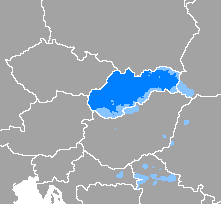
Hungarian, or Magyar, is a Uralic language of the Ugric branch spoken in Hungary and parts of several neighboring countries. It is the official language of Hungary and one of the 24 official languages of the European Union. Outside Hungary, it is also spoken by Hungarian communities in southern Slovakia, western Ukraine (Transcarpathia), central and western Romania (Transylvania), northern Serbia (Vojvodina), northern Croatia, northeastern Slovenia (Prekmurje), and eastern Austria (Burgenland).

Slovak, is a West Slavic language of the Czech–Slovak group, written in Latin script. It is part of the Indo-European language family, and is one of the Slavic languages, which are part of the larger Balto-Slavic branch. Spoken by approximately 5 million people as a native language, primarily ethnic Slovaks, it serves as the official language of Slovakia and one of the 24 official languages of the European Union.
The Hungarian alphabet is an extension of the Latin alphabet used for writing the Hungarian language.
Bunjevci are a South Slavic sub-ethnic group of Croats living mostly in the Bačka area of northern Serbia and southern Hungary, particularly in Baja and surroundings, in Croatia, and in Bosnia-Herzegovina. They presumably originate from western Herzegovina. As a result of the Ottoman conquest, some of them migrated to Dalmatia, from there to Lika and the Croatian Littoral, and in the 17th century to the Bácska area of Hungary.

Osijek-Baranja County is a county in Croatia, located in northeastern Slavonia and Baranja which is defined part of the Pannonian Plain. Its center is Osijek. Other towns include Đakovo, Našice, Valpovo, Belišće, and Beli Manastir.

Shtokavian or Štokavian is the prestige supradialect of the pluricentric Serbo-Croatian language and the basis of its Serbian, Croatian, Bosnian and Montenegrin standards. It is a part of the South Slavic dialect continuum. Its name comes from the form for the interrogative pronoun for "what" što. This is in contrast to Kajkavian and Chakavian.

Kajkavian is a South Slavic supradialect or language spoken primarily by Croats in much of Central Croatia and Gorski Kotar.

Baranya was an administrative county (comitatus) of the Kingdom of Hungary. Its territory is now divided between present-day Baranya County of Hungary and Osijek-Baranja County of Croatia. The capital of the county was Pécs.

Burgenland Croats are ethnic Croats in the Austrian state of Burgenland, along with Croats in neighboring Hungary and Slovakia.

The Bunjevac dialect, also known as Bunjevac speech, is a Neo-Shtokavian Younger Ikavian dialect of the Serbo-Croatian pluricentric language, preserved among members of the Bunjevac community mostly in the Bačka area of northern Serbia and southern Hungary, particularly in Baja and surroundings. It is also found in Croatia, and in Bosnia-Herzegovina. They presumably originate from western Herzegovina. Their accent is purely Ikavian, with /i/ for the Common Slavic vowels yat.

Burgenland Croatian is a regional variety of the Chakavian dialect of Croatian spoken in Austria, Hungary, the Czech Republic, and Slovakia. Burgenland Croatian is recognized as a minority language in the Austrian state of Burgenland, where it is spoken by 19,412 people according to official reports (2001). Many of the Burgenland Croatian speakers in Austria also live in Vienna and Graz, due to the process of urbanization, which is mostly driven by the poor economic situation of large parts of Burgenland.

Villány is a town in Baranya County, Hungary that is famous for its wine. Residents are Hungarians, with minority of Croats, Serbs and Germans of Hungary. Until the end of World War II, the inhabitants were Danube Swabians, also called locally as Stifolder, because their ancestors arrived around 1720 from Fulda (district). Most of the former German settlers were expelled to Allied-occupied Germany and Allied-occupied Austria in 1945–1948, pursuant to the Potsdam Agreement. Only a few Germans of Hungary live there, the majority today are descendant of Hungarians from the Czechoslovak–Hungarian population exchange. They received the houses of the former Danube Swabians inhabitants.
Dusnok is a village in Bács-Kiskun County, in the Southern Great Plain region of southern Hungary.

Kisjakabfalva is a village in Baranya county, Hungary. Until the end of World War II, the majority of the inhabitants were Danube Swabians, also called locally as Stifolder, because their ancestors arrived in the 17th and 18th centuries from Fulda (district). Most of the former German settlers were expelled to Allied-occupied Germany and Allied-occupied Austria in 1945–1948, as a result of the Potsdam Agreement. Only a few Germans of Hungary live there, the majority today are the descendants of Hungarians from the Czechoslovak–Hungarian population exchange. They occupied the houses of the former Danube Swabian inhabitants.

Croats of Serbia or Serbian Croats are a recognized national minority in Serbia. According to the 2022 census, the population of ethnic Croats in Serbia is 39,107, constituting 0.6% of the total population. The vast majority of them live in the northern autonomous province of Vojvodina, where they number 32,684 and make up 1.9% of the province's population. An additional 11,104 people declared themselves as Bunjevci in the 2022 census; there are differing views whether Bunjevci should be regarded as Croats or as members of a distinct ethnic group. The majority of the Sokac community consider themself as Croats. Not all Croats have Bunjevac or Sokac ancestors.

Miklós Zrínyi was a Croatian and Hungarian military leader, statesman and poet. He was a member of the House of Zrinski, a Croatian-Hungarian noble family. He is the author of the first epic poem, The Peril of Sziget, in Hungarian literature.

Croatian is the standardised variety of the Serbo-Croatian pluricentric language mainly used by Croats. It is the national official language and literary standard of Croatia, one of the official languages of Bosnia and Herzegovina, Montenegro, the Serbian province of Vojvodina, the European Union and a recognized minority language elsewhere in Serbia and other neighbouring countries.

The Hungarian Croats are an ethnic minority in Hungary. According to the 2011 census, there were 26,774 Croats in Hungary or 0.3% of population.
The Fiuman dialect is the dialect of the Venetian language spoken in the Croatian city of Rijeka (Fiume). It is strongly influenced by Croatian Chakavian, Hungarian, German substrates, mainly due to the closeness between two different cultures and Austro-Hungarian rule.

The dialects of Serbo-Croatian include the vernacular forms and standardized sub-dialect forms of Serbo-Croatian as a whole or as part of its standard varieties: Bosnian, Croatian, Montenegrin, and Serbian. They are part of the dialect continuum of South Slavic languages that joins through the transitional Torlakian dialects the Macedonian dialects to the south, Bulgarian dialects to the southeast and Slovene dialects to the northwest.


















